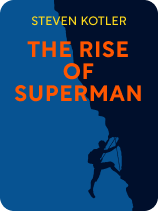

This article is an excerpt from the Shortform book guide to "The Rise of Superman" by Steven Kotler. Shortform has the world's best summaries and analyses of books you should be reading.
Like this article? Sign up for a free trial here.
Why is it important to set realistic yet challenging goals? How can you set these kinds of goals?
According to author and journalist Steven Kotler, it’s much easier to concentrate on and achieve realistic goals rather than overly ambitious ones. In The Rise of Superman, Kotler provides useful suggestions on how to set realistic goals that still provide some level of challenge.
Read on to learn how to set realistic yet challenging goals, according to Kotler.
How to Set Realistic Goals
According to Steven Kotler, the type of goal you set out to accomplish factors into your ability to focus on and achieve that goal. Kotler has spent a great deal of time studying the effects of focus on performance and achievement. He is a New York Times bestselling author and founder of the Flow Research Collective, which studies the neuroscience behind peak performance. In this article, we’ll explain how to set realistic yet challenging goals and why it’s important, according to Kotler’s book The Rise of Superman.
First, we’ll explain how you can set realistic goals that allow for deep concentration.
1. Find something you’re passionate about. Since enjoyment is necessary to find flow, Kotler suggests that you find something you want to achieve because you’re internally motivated to do so rather than because of outside influence. If you’re internally motivated to do something, you’ll find it easier to be more focused. On the other hand, if you’re motivated by external forces, like receiving money or avoiding punishment, you might be tempted to find distractions such as checking your phone every few minutes.
(Shortform note: Several experts weigh in with suggestions on how you can identify your passions. In Minimalism, Joshua Fields Millburn and Ryan Nicodemus suggest you consider the past experiences in your life that excited you the most. In The Happiness Project, Gretchen Rubin recommends you think about what you spent your time doing during your childhood or what you spend your free time on now to pinpoint your passions.)
2. Separate your goal into small yet challenging chunks. First, to set a realistic goal, your goal must be clear enough for you to know what actions to take to achieve it and determine whether you’ve been successful. Additionally, ensure your goal is manageable so you don’t feel overwhelmed by the challenge.
For example, if your goal is to become fluent in French, you might become so overwhelmed by all you must learn that you fail to make progress. Instead, to set a realistic goal, break up this big goal into smaller, measurable tasks, such as learning the alphabet or learning how to conjugate verbs.
(Shortform note: In 1981, psychologists Albert Bandura and Dale Schunk conducted a study with groups of children to compare the effects of setting smaller goals versus one large goal. They gave one group the goal of completing 42 pages of math problems in seven sessions. For another, they suggested the children try to complete six pages of math problems in each session. Ultimately, they found that working toward subgoals resulted in faster completion and better performance than working with one large goal.)
Kotler says that the difficulty level of your goal matters, too. If your task is too easy, you can lose interest and become distracted. Kotler recommends setting challenges that are 4% more advanced than your current skill level. Such challenges help you focus but don’t overwhelm you.
(Shortform note: In Atomic Habits, James Clear agrees with Kotler on the importance of setting appropriately challenging goals, adding that boredom is one of the biggest obstacles to motivation. He refers to finding the right challenge-to-skill-level ratio as the Goldilocks Rule and suggests you set goals where there’s a 50/50 chance of succeeding. With a nearly equal risk of failure and hope of success, this approach keeps you focused and ensures you’ll feel more satisfied when you accomplish your goal.)
Why You Should Set Realistic Yet Challenging Goals
Setting realistic yet challenging goals helps you find focus and improve your skills by allowing you to:
1. Adjust your performance. When you break your objective into smaller tasks, you can assess and adjust your performance at each step of the way rather than at the very end. Kotler says that for extreme athletes, this automatic feedback is built into their sports. Take rock climbing, for example: When you fall, you immediately recognize what mistake led to that result. This allows you to focus on what you need to readjust for your next attempt.
However, some tasks have less feedback. For example, if you’re developing an online game, you won’t know whether you’re doing something well until you release it for others to play. In this case, Kotler suggests you ask for input at each step. If you’ve completed the first level of a platform game, ask people to try it out and offer feedback. This allows you to identify any flaws to your approach when everything’s still fresh in your mind.
(Shortform note: In Ultralearning, Scott Young agrees with Kotler’s suggestion of receiving feedback quickly, adding that your abilities increase with more immediate feedback, while delayed feedback might result in even worse performance. However, he warns that getting feedback too quickly, such as interrupting yourself every few minutes to evaluate, prevents you from absorbing the knowledge and applying it to your next attempt. For example, if you’re practicing phrases to learn a foreign language and forget a few words, don’t consult the answers immediately. Try to reflect on it longer so that your brain can better process the information.)
2. Visualize what’s possible. According to Kotler, having clear goals makes it easier to visualize yourself accomplishing them, which improves your focus and performance. Kotler cites research demonstrating that when you imagine yourself doing something, you’re activating the same neurons that fire when you’re physically performing the action. Essentially, by visualizing yourself doing something, you’re increasing your ability to achieve it.
(Shortform note: In The Miracle Morning, Hal Elrod provides three steps to help you visualize your goals. First, prepare by sitting comfortably, clearing your mind, and possibly playing instrumental music. Next, use your five senses to imagine yourself accomplishing your goal and the feeling of satisfaction after you’ve achieved it. Finally, turn your focus inward and picture the type of person you’ll need to be to accomplish that goal. To aid your visualization, you can even consider creating a poster board with images that inspire you.)
Exercise: Set a Realistic Yet Challenging Goal
According to Kotler, we can encourage flow by setting challenging yet realistic goals that we’re passionate about. Let’s practice creating a flow-inducing goal.
- Think about a broad goal that you’re passionate about. What personally motivates you to achieve this goal? For example, your broad goal might be to become a concert pianist because you enjoy making others happy through your music.
- Now, break your goal into several small, achievable chunks. And since Kotler explains that feedback is important so you can adjust your approach, make sure you can obtain some form of feedback once you complete each chunk. For example, your first small goal might be to play a complete piano piece in a public space.
- Next, a flow-inducing goal must be challenging—Kotler specifically recommends the goal be 4% harder than what you’re currently capable of achieving. Based on the chunks you broke your overarching goal into in the last question, how can you make them slightly harder? For example, you could try to learn a piece of music with more complex rhythms than you’ve worked with before.
- Finally, if you get stuck while working toward your challenging yet achievable goal, what are one or two relaxing or enjoyable activities you can do to give your mind a break?

———End of Preview———
Like what you just read? Read the rest of the world's best book summary and analysis of Steven Kotler's "The Rise of Superman" at Shortform.
Here's what you'll find in our full The Rise of Superman summary:
- The importance of mastering flow for any activity
- The neuroscience behind the flow state
- Techniques for how you can encourage deep focus into your life






